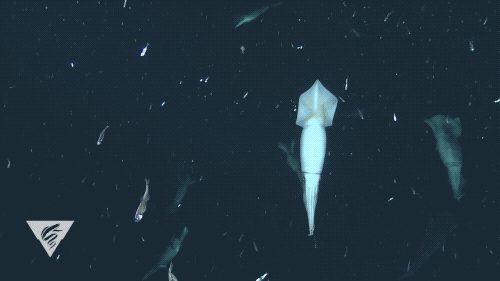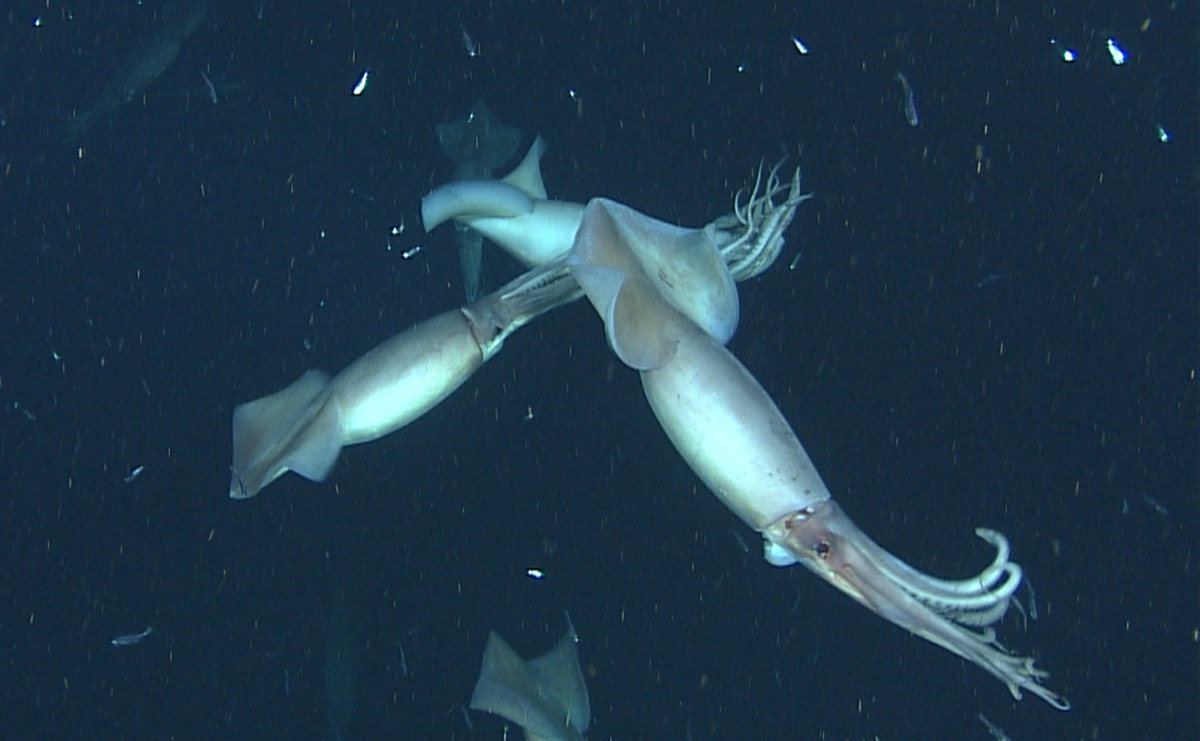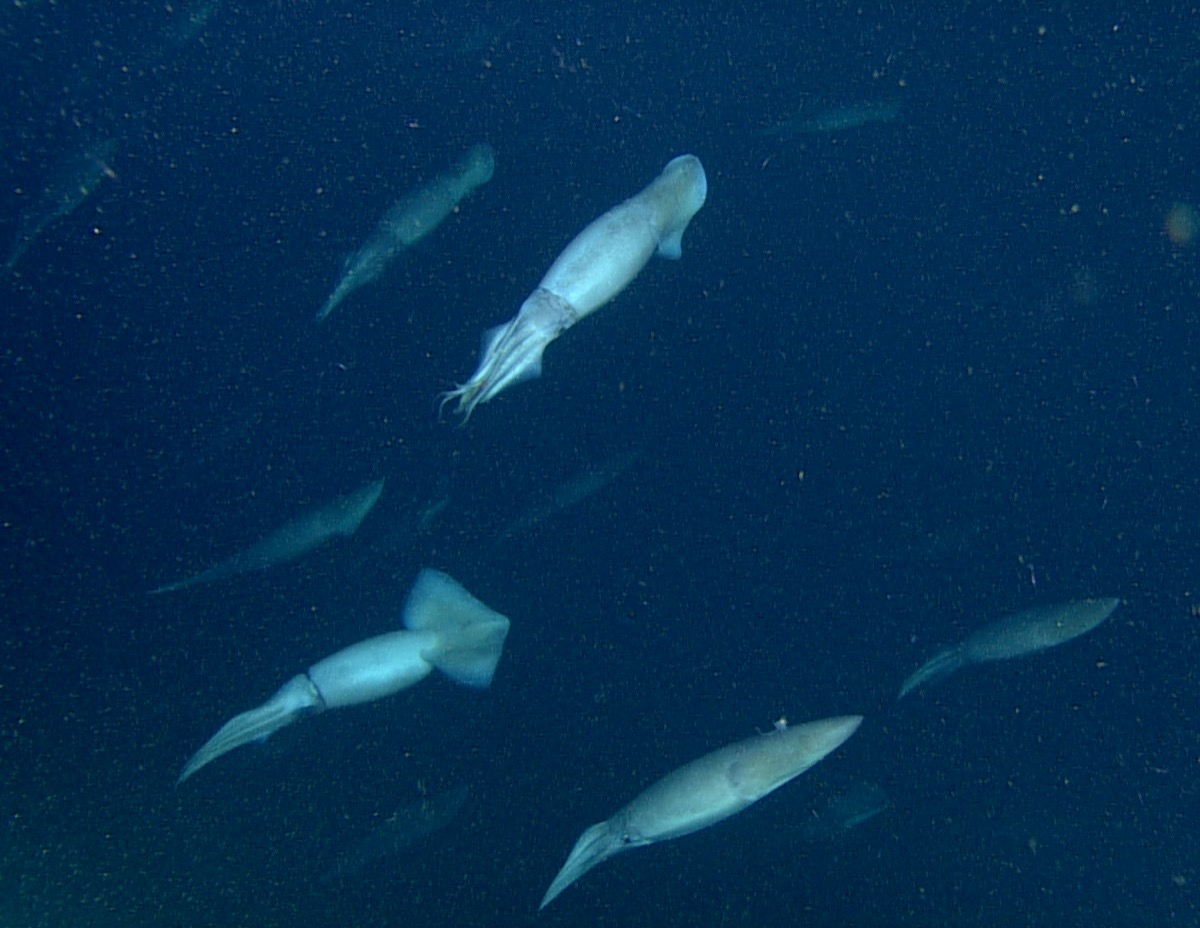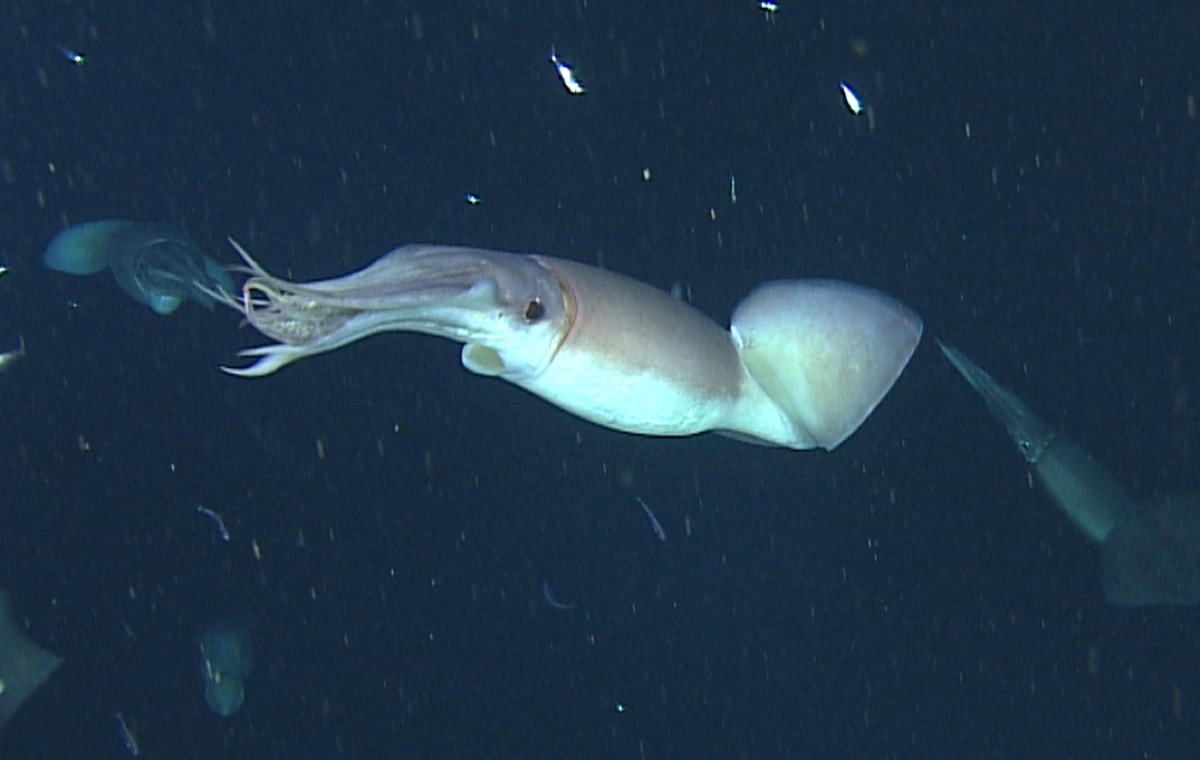How Humboldt Squid Talk To Each Other In The Dark
11:38 minutes

Cephalopods are masters of changing their bodies in response to their environments—from camouflaging to sending warning signals to predators. The art of their visual deception lies deep within their skin. They can change their skin to different colors, textures, and patterns to communicate with other animals and each other. But how does this play out in the darkness of the deep ocean? That’s the question a team of scientists studied in the deep diving Humboldt squid that lives over 2,000 feet beneath the ocean’s surface. Their results were published this week in the journal Proceedings of the National Academy of Sciences. Biologist Benjamin Burford, who is an author on that study, explains how Humboldt squid use a combination of skin color patterns and bioluminescence to send each other signals and what this might teach us about communication in the deep ocean. See a video and more photos of Humboldt squid communicating with each other from Monterey Bay Aquarium Research Institute.



Invest in quality science journalism by making a donation to Science Friday.
Benjamin Burford is a Ph.D. Candidate in Biology at Stanford University in Stanford, California.
IRA FLATOW: This is Science Friday. I’m Ira Flatow. Just a note due to the need for social distancing this week, we won’t be taking calls during this edition of Science Friday, which was pre-recorded earlier in the week. A bit later in the hour, bacteria on your tongue and Pablo Escobar’s hippos.
But first, cephalopods, as we know and love, are clever creatures. And one of their most fascinating features is their skin. That can change their skin to different colors, textures, and patterns to communicate with other animals and each other.
But how does this play out in the deep ocean where it’s total darkness? That’s the question a team of scientists was trying to figure out. And for the answer, they looked to the deep diving Humboldt squid that lived over 2000 feet down.
Their results were published this week in the journal, Proceedings of the National Academy of Sciences. Our Producer, Alexa Lim, spoke with Benjamin Burford a PhD candidate in biology and an author on that study.
ALEXA LIM: Hi, Ben. Welcome to Science Friday.
BENJAMIN BURFORD: Hey, thanks for having me.
ALEXA LIM: You could have picked any animal in the deep ocean. What makes the Humboldt squid a good candidate for studying communication?
BENJAMIN BURFORD: One thing that’s really cool about squid is that they have these crazy pigmentation patterns that they’re able to display on their skin. So it’s pretty easy to see their communications.
ALEXA LIM: And Humboldt squid, they’re pretty social, right?
BENJAMIN BURFORD: Highly social. They live in groups. You know, sometimes, we see several of them. Sometimes we see hundreds of them. So I mean you could picture, in some cases, these animals you know get up too close to two meters long. So you can picture a pack of about hundreds of those rolling, 102-meter long squid roaming through the deep sea.
ALEXA LIM: And so you were looking at communication in the deep ocean. How much do we know about how animals communicate down there?
BENJAMIN BURFORD: What’s really known about animal communication down there. You know we’re starting to observe these animals in their natural habitat more and more and learn more there. But a lot of what we know is what’s been observed when some of these animals migrate shallower during the night or you know by just looking at the animal’s anatomy.
So a lot of animals in the deep ocean– you know, it’s a dark environment by and large. There can be a dim light– but the a lot of animals visually communicate by making their own light through a process called bioluminescence. And the way they make their own light is they use these organs called photophores.
And by looking at how these organs are arranged, you know, we know that some animals are probably able to say things like this is the species I am, or I’m a male, or I’m a female, or stuff like that. So pretty basic information is what we knew was communicated visually in the deep ocean prior to this study.
ALEXA LIM: And that’s what you’re trying to get to at this study, and you used to ROV to take live videos of the squid. What did you see when you turned on the light for the ROV?
BENJAMIN BURFORD: One thing that make Humboldt squid such great study subjects is they’re gregarious. They’re inquisitive. They’re fairly bold as far as deep sea animals go. I mean, again, they feel pretty confident it seems. And they’ll approach the vehicle. In fact, the vehicle is large and noisy, and it scares a lot of deep sea animals, but the Humboldt squid seem to seek it out.
So they find us when we’re down there. When we dive this thing down hundreds of meters into the ocean, the Humboldt squid find us if they’re around. They like the vehicles. You know, they’re curious about it, but they also use the lights to forage by.
You know, we see these dense eating aggregations in front of the vehicle. And they kind of look like feeding frenzies. It looks pretty hectic. But if you pay close attention, you’ll notice they’re not bumping into each other. They’re not fighting amongst each other. They’re rarely in competition even for the same prey item.
And so in our view, you know they must have some way of coordinating this activity. And they’re visually cute animals. So presumably, the way they signal we thought was through a visual pathway using pigmentation patterns like they’re shallow-living counterparts.
ALEXA LIM: So what signals did you see? What patterns were they making to each other?
BENJAMIN BURFORD: The patterns, in some cases, they resemble patterns that we see in shallow-living squids. The pigmentation patterns that they would make, you know, would take advantage of most of their body surfaces. So they might make patterns that involve pigment on their fins on their head on their mantle, which is kind of, you know, the central part of a squid. It’s like the biggest muscular cavity really, and it has all the organs inside of it. That is a surface that a lot of the pigmentation patterns use.
And so you know, the squid are using their skin to make these pigmentation patterns. And you know, an example of a really conspicuous pattern that they might do is they might make half of their body dark and half of it pale, and it’d be like their left side would be dark, and their right side would be pale.
There are a lot of other conspicuous patterns like that. There are also some more subtle patterns like, you know, maybe a dark spot between the eyes on top of the head. And I should point out you know they can combine these patterns. They can arrange them in sequence, and they can transition between them very quickly like with the snap of your finger. You know, they can change pigmentation pattern from one to the other.
ALEXA LIM: So they’re actually like stacking these different signals on top of each other. Is that what they’re doing?
BENJAMIN BURFORD: Yeah, in some cases, some signals are compatible to put together. They’re able to arrange any of them in sequence if they want to. So like do like the half light half dark and then they might transition to all dark, or all pale, or just a dark margin of their fins, or something we call model where there’s this like mosaic of pigmentation that kind of flows around their body in a way. It’s very cool.
ALEXA LIM: What were they using these signals for? Was it like when you lean into your car horn to say move out of my way, or was it more like you put on your blinker and your kind of trying to direct traffic and asking to move into a new lane?
BENJAMIN BURFORD: Yeah. I think it’s pretty similar to like you know driving in heavy traffic with a lot of aggressive drivers. And thank goodness, I have turn signals, and brake lights, and you know horn– things like that on my car that helped me navigate that situation, because I think similarly, these squid down in the deep feeding, I think a lot of what they’re doing is to essentially prevent catastrophe just like the turn signals and traffic. You know, it’s preventing an accident.
Like a lot of their pigmentation patterning is geared at indicating intent and things about perhaps their social dominance or things like that, stuff that helps the squid avoid antagonistic interactions, because those are costly. And if you can avoid those when possible, you know, that’ll help you save energy, and resources, and prevent unnecessary damage or being eaten, things like that.
ALEXA LIM: Right. OK, so for the study, you had the ROV lights on so you could see the squid and could see these patterns. But what happens when it’s lights out. How do the squids see each others signals?
BENJAMIN BURFORD: I wish we had the low light cameras during the study to be able to see what we think is going on. But I’ll tell you what we think is going on. So Humboldt squid, like I mentioned earlier, they, like some other deep living animals, have light producing organs, these photophores, where the photophores I described earlier in a lot of deep sea animals and even in you know many animals that live on land that we’re familiar with like fireflies, like a lot of those photophores are designed to project light outward. The light producing organ, in some cases, will be encased in like a silvery lining. And that really helps the light get out.
But the photophores of the Humboldt squid are a little different. They’re really rudimentary. They’re very small. They’re like little grains of sand or grains of rice kind of, and they’re embedded in the animal’s muscle tissue. And a single animal may have hundreds and will be spread throughout the body. And what these do instead of projecting light outward, they’ll radiate light within the animal’s body. So the animals can make themselves glow with these photofores.
And so we think they’re basically making their bodies glow and then projecting pigmentation patterns on top of that glowing backdrop. So if you think of like the classic pigmentation pattern communication paradigm, you know, where the squid in shallow water when they’re making these patterns, you can think of them kind of as like words on a book. And you know, you need light to be able to read those words, to read the book. You can’t read the book in the dark.
But the Humboldt squid, we think basically turn themselves into e-readers. So as opposed to having to shine light on the Humboldt squid, the Humboldt squid backlights the words if you will. So you can read your e-reader in the dark before you go to bed, but you know, you can’t do that with a book.
But it seems like the two are linked further in that these light producing organs, they’re not just randomly spread throughout squids body. And what we did is, you know, we kind of mapped where those were, and then we found that those regions of higher than average photophore density corresponded to being right underneath where some of these subtle, but important communication pigmentation patterns were.
We think they might be able to glow a little bit more brightly in some regions of their body more than others. This could help enhance the visibility of some patterns that might be a little bit subtle.
ALEXA LIM: So it’s like a backlight and a highlighter on your e-reader.
BENJAMIN BURFORD: Yeah, exactly. I hadn’t thought of that. Highlighter, nice.
ALEXA LIM: OK. The Humboldt squid has complex communication, but would you call it language?
BENJAMIN BURFORD: I mean, the moral of the story there is like, no, we could definitely not call it a language by any means at this point. Who knows if future research would even show they have the capability for a language? But you know, I think our research hints at them having perhaps some elements that we wouldn’t have expected just based on their habitat and their social structure.
ALEXA LIM: So then what does this tell us about communication in the deep ocean?
BENJAMIN BURFORD: I think it expands the possibilities. So the deep ocean, it’s this massive habitat that’s mostly dark. It’s empty. It’s not a lot of structural complexity at all. And so you know, it’s been thought that visual signals would be pretty basic, but I think this expands the possibilities.
In theory, these squid can say a whole lot more than we previously thought in the deep ocean. These animals, their predators, they’re really abundant. So Humboldt squid and the group of open-ocean squid that they belong to, they’re the most abundant and ecologically important squid on the planet. You know, these animals, they’re moving about, eating stuff, pooping, mating, being eaten. And where they go and what decisions they make are pretty important for processes out in the open ocean.
They’re probably making decisions based on what they’re saying to each other, and that might influence processes in the ocean. I just think it’s fascinating to think that as you and I are talking right now, they are probably squid talking to each other in the deep ocean. And yeah, they’re probably sharing all sorts of information.
ALEXA LIM: Great. Well thanks, Ben. Thanks for joining us.
BENJAMIN BURFORD: Absolutely. Thanks for having me.
IRA FLATOW: Producer Alexa Lim, speaking with Benjamin Burford, a PhD candidate in biology at Stanford University.
Copyright © 2020 Science Friday Initiative. All rights reserved. Science Friday transcripts are produced on a tight deadline by 3Play Media. Fidelity to the original aired/published audio or video file might vary, and text might be updated or amended in the future. For the authoritative record of Science Friday’s programming, please visit the original aired/published recording. For terms of use and more information, visit our policies pages at http://www.sciencefriday.com/about/policies/
Alexa Lim was a senior producer for Science Friday. Her favorite stories involve space, sound, and strange animal discoveries.
Ira Flatow is the founder and host of Science Friday. His green thumb has revived many an office plant at death’s door.